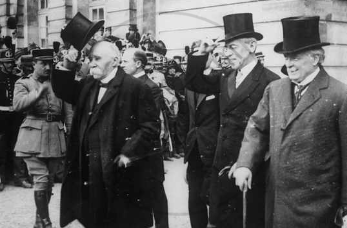Advertisements
Advertisements
प्रश्न
Describe any four aims of the peace programme of Woodrow Wilson.
उत्तर
President Woodrow Wilson of America was a very peace loving man. In January, 1918, he put forward a peace programme consisting of fourteen points to end the First World War. These points included:
(i) Discard of secret treaties,
(ii) Freedom ip the use of seas by all nations,
(iii) Reduction in armaments,
(iv) Conduct of negotiations between different states openly,
(v) Evacuation of Belgium by Germany,
(vi) Restoration of Alsace-Lorraine to France,
(vii) Creation of independent States in Europe, and
(viii) Establishment of a world organisation to guarantee political independence and territorial integrity of different States.
Many of the above points were covered by the different treaties that were signed after the First World War. For instance, Belgium \yas evacuated by Germany: Alsace and Lorraine were returned to France; many small states like Poland, Finland, Czechoslovakia, Latvia, etc. were created on the.principle of nationality, and an international organisation with the name of the League of Nations was created to maintain the world peace.
APPEARS IN
संबंधित प्रश्न
The War that broke out in 1914 was different from the previous wars in many ways. In this context discuss the following points briefly:
How did the treaty of Versailles seek to cripple Germany’s military strength?
The War that broke out in 1914 was different from the previous wars in many ways. In this context discuss the following points briefly:
What was the territorial rearrangement of Europe as a result of this War?
Mention any two terms of the Treaty of Versailles signed On June 28, 1919.
Mention the dictatorship that emerged in Europe after the war.
How many articles were there in the Treaty of Versailles?
What was the number of war criminals of Germany who were identified?
How was the outbreak of the Second World War an outcome of the First World War?
Discuss about the loss of life and money occured due to First World War.
Answer the following:
(i) Name the three gentlemen in the picture.
(ii) With which settlement they were associated.
|
The final act of the long-drawn-out negotiations took place at Versailles on Saturday afternoon and to-day Germany and the Allies - always with the exception of America - are at peace. Peace is a blessed word and both the word and the fact are welcome to-day. So far as Germany is concerned, there is for the present, an end of strife and at least a formal return to the decent relations of civilised states. Editorial: Peace in force (12 January 1920) The Guardian |
Name the organization which was established in 1920 to maintain peace after this war.
